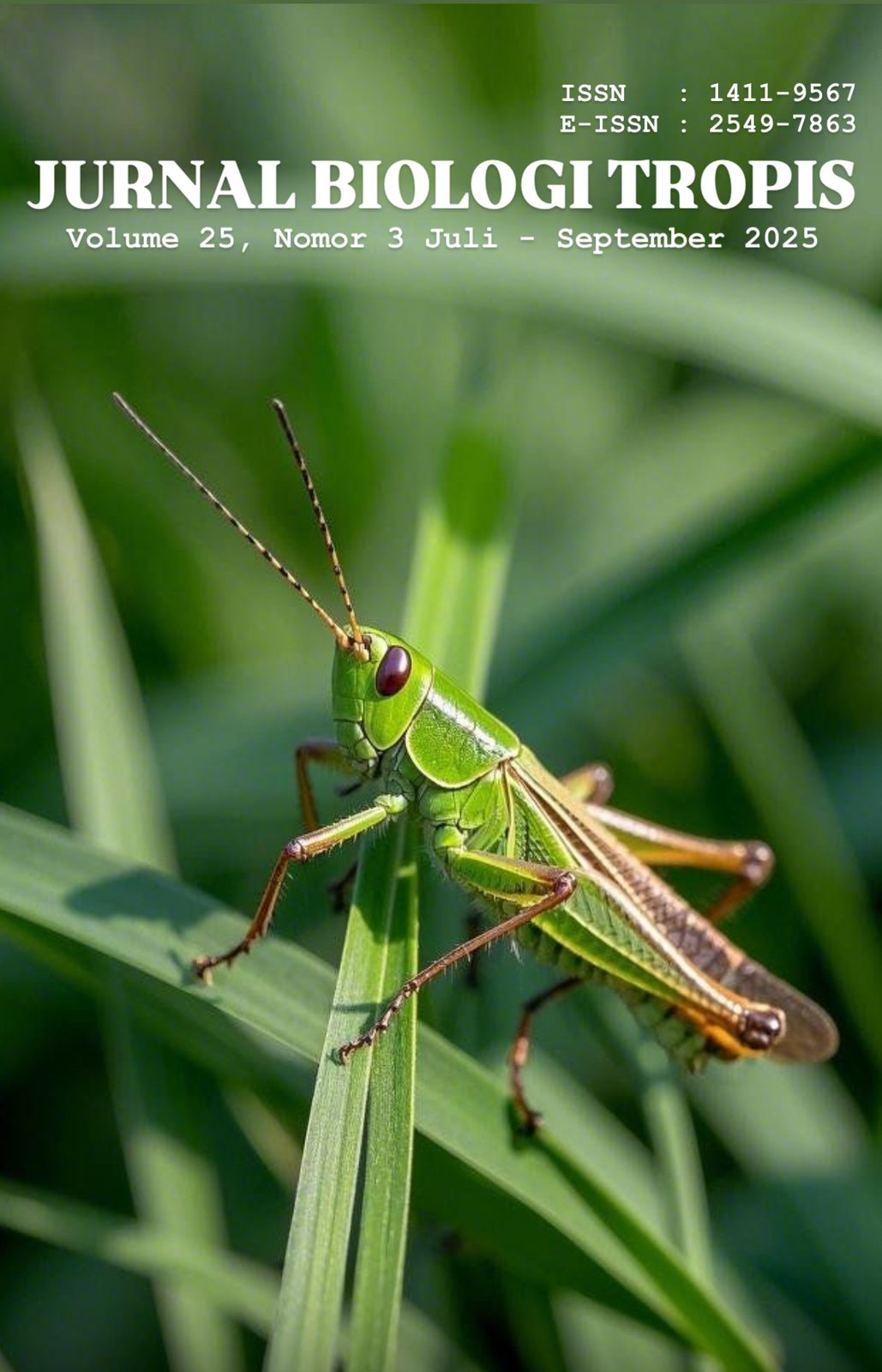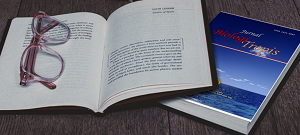Male and Female Pigeons (Columba livia-domestica) Behaviors in Matchmaking Period: Patterns and Interactions
Authors
Anwari Adi Nugroho , Muthia Mardyah , Dian Andhi Saputra , Sarima Sarima , Muhammad Nur HidayadDOI:
10.29303/jbt.v25i3.9540Published:
2025-07-14Issue:
Vol. 25 No. 3 (2025): Juli-SeptemberKeywords:
Behavior, columba livia-domestica, mating.Articles
Downloads
How to Cite
Downloads
Metrics
Abstract
This study explores the social interaction behaviors of domestic pigeons (Columba livia domestica) during the matchmaking period. The aim is to understand how multi-channel communication through body movements, vocalizations, and tactile contact affects the formation of pair bonds. This research employed an observational method at the Green House of Universitas Veteran Bangun Nusantara using the ad libitum sampling technique to record daily behaviors of pigeons kept in a confined space. The results revealed that male pigeons predominantly initiate interactions, while females exhibit selective responses that determine mating success. Characteristic behaviors such as bowing, cooing, billing, and allopreening were observed to follow a sequential pattern from orientation and approach to attraction and acceptance. These findings suggest that the intensity and consistency of social interactions significantly contribute to successful pair bonding in domestic pigeons. Future research may investigate hormonal or neurological aspects that underlie these social behaviors.
References
Adkins-Regan, E. (2005). Hormones and animal social behavior. Princeton University Press. https://doi.org/10.1515/9781400850778
Andersson, M. (1994). Sexual Selection. Princeton University Press.
Ball, G. F., & Balthazart, J. (2010). Neuroendocrine regulation of reproductive behavior in birds. In M. D. Breed & J. Moore (Eds.), Encyclopedia of Animal Behavior (Vol. 2, pp. 559–567). Academic Press. DOI: https://doi.org/10.1016/B978-008088783-8.00025-5
Bouchard, J., Goodyer, W., & Lefebvre, L. (2007). Social learning and innovation are positively correlated in pigeons (Columba livia). Animal cognition, 10, 259-266. https://doi.org/10.1007/s10071-006-0064-1
Catchpole, C. K., & Slater, P. J. B. (2008). Bird Song: Biological Themes and Variations (2nd ed.). Cambridge University Press.
Cooney, C. R., Varley, Z. K., Nouri, L. O., Moody, C. J. A., et al. (2019). Sexual selection predicts the rate and direction of colour divergence in a large avian radiation. Nature Communications, 10(1), 1773. https://doi.org/10.1038/s41467-019-09859-7
Dahrun, M., Langoy, M. L., & Wahyudi, L. (2019). Karakteristik gaya aerodinamika pada burung merpati (Columba livia). Pharmacon, 8(3), 679-685. https://doi.org/10.35799/pha.8.2019.29392
Darwati, S., Martojo, H., Sumantri, C., Sihombing, D. T. H., & Mardiastuti, A. (2010). Productivity, repeatability of productive and reproductive traits of local pigeon. Journal of the Indonesian Tropical Animal Agriculture, 35(4), 268-274. https://doi.org/10.14710/jitaa.35.4.268-274
Dial, K. P. (1992). Activity patterns of the wing muscles of the pigeon (Columba livia) during different modes of flight. Journal of Experimental Zoology, 262(4), 357-373. https://doi.org/10.1002/jez.1402620402
Elie, J. E., Hoffmann, S., Dunning, J. L., Coleman, M. J., Fortune, E. S., & Prather, J. F. (2020). From perception to action: the role of auditory input in shaping vocal communication and social behaviors in birds. Brain Behavior and Evolution, 94(1-4), 51-60. https://doi.org/10.1159/000504380
Erdem, E., Bulut, F. T. Ö., & Eser, E. (2024). Understanding The Behaviors Of Pigeons. Innovative Multifaceted Developments in Veterinary Medicine, 165.
Fabricius, E., & Jansson, A. M. (1963). Laboratory observations on the reproductive behaviour of the pigeon (Columba livia) during the pre-incubation phase of the breeding cycle. Animal Behaviour, 11(4), 534-547. https://doi.org/10.1016/0003-3472(63)90276-8
Fernandez, E. J., & Lattal, K. A. (2025). Pigeon in a Box: Columba livia as Subject in Behavioral Research. Perspectives on Behavior Science, 1-14. https://doi.org/10.1007/s40614-025-00454-4
Goodwin, D. (1983). Pigeons and doves of the world (3rd ed.). Cornell University Press.
Jacquin, L., Cazelles, B., Prevot-Julliard, A. C., Leboucher, G., & Gasparini, J. (2010). Reproduction management affects breeding ecology and reproduction costs in feral urban pigeons (Columba livia). Canadian Journal of Zoology, 88(8), 781-787. https://doi.org/10.1139/Z10-044
Johnston, R. F., & Johnson, S. G. (1989). Nonrandom mating in feral pigeons. The Condor, 91(1), 23–29. https://doi.org/10.2307/1368144
Kadri, M. H. M., Septinova, D., & Riyanti, R. (2016). Karakteristik dan Perilaku Merpati Tinggi Lokal Jantan dan Betina. jurnal ilmiah Peternakan Terpadu, 4(2). DOI: http://dx.doi.org/10.23960/jipt.v4i2.p%25p
Kerfoot, EM (1964). Beberapa aspek pemilihan pasangan pada merpati domestik (Disertasi doktoral, Universitas Oklahoma).
Kroodsma, D. E., & Byers, B. E. (1991). The function(s) of bird song. American Zoologist, 31(2), 318–328. https://doi.org/10.1093/icb/31.2.318
Lynn, S. E. (2016). Endocrine and neuroendocrine regulation of fathering behavior in birds. Hormones and Behavior, 77, 237-248. https://doi.org/10.1016/j.yhbeh.2015.04.005
Majewska, D., & Drenikowski, T. (2016). Analysis of reproduction and growth in fancy pigeons. Acta Scientiarum Polonorum. Zootechnica, 15(1). https://doi.org/10.1139/Z10-044
Murton, R. K., & Isaacson, A. J. (1962). The functional basis of some behaviour in the Wood Pigeon Columba palumbus. Ibis, 104(4), 503–521. https://doi.org/10.1111/j.1474-919X.1962.tb08683.x
Pranoto, E. A., Susetyorini, R. E., & Prihanta, W. (2015). Identifikasi Burung di Kepulauan Kai Maluku Tenggara. In Prosiding Seminar Nasional Pendidikan Biologi 2015 Program Pendidikan Biologi Fakultas Keguruan Ilmu Pendidikan Universitas Muhammadiyah Malang (Vol. 772).
Sardell, R. J., Kempenaers, B., & DuVal, E. H. (2014). Female mating preferences and offspring survival: testing hypotheses on the genetic basis of mate choice in a wild lekking bird. Molecular Ecology, 23(14), 3706–3718. https://doi.org/10.1111/mec.12652
Saxena, VL, Pandey, E., Agarwal, S., & Saxena, AK (2008). Execution of Breeding and Nidification Behaviour in Pigeon (Columba livia) and Dove (Streptopelia chinensis). Asian J. Exp. Sci , 22 (3), 405-410.
Shetty, S., Jacob, R. T., Shenoy, K. B., & Hegde, S. N. (1990). Patterns of breeding behaviour in the domestic pigeon. Bird Behavior, 9(1-2), 14-19. https://doi.org/10.3727/015613890791749028
Shimizu, T., & Bowers, A. N. (1999). Visual circuits of the avian telencephalon: Evolutionary implications. Behavioural Brain Research, 98(2), 183–191. https://doi.org/10.1016/S0166-4328(98)00083-7
Syifa, N. (2022). Kajian Metodologi Keilmuan Etologi (Doctoral dissertation, UIN Raden Intan Lampung).
Unwin, M. (2011). The atlas of birds: diversity, behavior, and conservation. Princeton University Press.
Wang, L., Zhu, J., Xie, P., & Gong, D. (2023). Pigeon during the breeding cycle: behaviors, composition and formation of crop milk, and physiological adaptation. Life, 13(9), 1866. https://doi.org/10.3390/life13091866
Ware, E. L., Saunders, D. R., & Troje, N. F. (2017). Social interactivity in pigeon matchmaking behavior. Current Zoology, 63(1), 85-95. https://doi.org/10.1093/cz/zow066
Author Biographies
Anwari Adi Nugroho, Program Studi Pendidikan Biologi, Universitas Veteran Bangun Nusantara
Program Studi Pendidikan Biologi, Universitas Veteran Bangun Nusantara
Muthia Mardyah, Program Studi Pendidikan Biologi, Universitas Veteran Bangun Nusantara
Program Studi Pendidikan Biologi, Universitas Veteran Bangun Nusantara
Dian Andhi Saputra, Program Studi Pendidikan Biologi, Universitas Veteran Bangun Nusantara
Program Studi Pendidikan Biologi, Universitas Veteran Bangun Nusantara
Sarima Sarima, Program Studi Pendidikan Biologi, Universitas Veteran Bangun Nusantara
Program Studi Pendidikan Biologi, Universitas Veteran Bangun Nusantara
Muhammad Nur Hidayad, Program Studi Pendidikan Biologi, Universitas Veteran Bangun Nusantara
Program Studi Pendidikan Biologi, Universitas Veteran Bangun Nusantara
License
Copyright (c) 2025 Anwari Adi Nugroho, Muthia Mardyah, Dian Andhi Saputra, Sarima Sarima, Muhammad Nur Hidayad

This work is licensed under a Creative Commons Attribution 4.0 International License.

Jurnal Biologi Tropis is licensed under a Creative Commons Attribution 4.0 International License.
The copyright of the received article shall be assigned to the author as the owner of the paper. The intended copyright includes the right to publish the article in various forms (including reprints). The journal maintains the publishing rights to the published articles.
Authors are permitted to disseminate published articles by sharing the link/DOI of the article at the journal. Authors are allowed to use their articles for any legal purposes deemed necessary without written permission from the journal with an acknowledgment of initial publication to this journal.


























